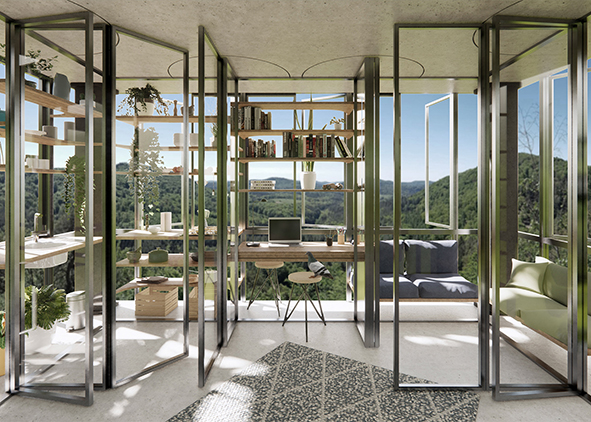An ecology of space. Architectural design for transboundary relationships
DOI:
https://doi.org/10.19229/2464-9309/13132023Keywords:
ecology, architecture, window, façade, ambiguous spaceAbstract
While architectural discussions on ecology focus on technical considerations, a deeper understanding of the notion and its aspects of the inter-relationality between things and beings presents a broader perspective. Ecological architecture could play a central role in shaping the relationships that human beings have with their environment. By identifying the façade as the focal point for cross-border relationships linking interior and exterior spaces, an analysis of historical and contemporary architecture shows how architects have designed transitional spaces to promote these relationships. Such ambiguous spaces are exemplarily found in historic box-type windows, initially intended for thermal insulation. Even these little transitional spaces bear the potential of mediating between inside and out. In this sense, architecture might assume a central ecological role in shaping the relationships humans entertain with their environments.
Article info
Received: 20/03/2023; Revised: 09/05/2023; Accepted: 01/06/2023
Downloads
Article Metrics Graph
References
Alexander, C., Ishikawa, S. and Silverstein, M. (1977), A Pattern Language – Towns, Buildings, Construction, Oxford University Press, New York. [Online] Available at: arl.human.cornell.edu/linked%20docs/Alexander_A_Pattern_Language.pdf [Accessed 17 May 2023].
Barad, K. (2007), Meeting the Universe Halfway, Duke University Press, Durham.
Boettger, T. (2014), Schwellenräume, Birkhäuser, Basel.
Braun, K. and Klos, H. (2010), Isolierglasfenster, Holzmanufaktur Rottweil GmbH, Rottweil. [Online] Available at: holzmanufaktur-rottweil.de/ fileadmin/user_upload/Publikationen/PDF/Holzmanufaktur _Isolierglasfenster.pdf [Accessed 17 May 2023].
European Commission (2021), Communication from the Commission to the European Parliament, the European Council, the Council, the European Economic and Social Committee and the Committee of the Regions – New European Bauhaus Beautiful, Sustainable, Together, document 52021DC0573, 573 final. [Online] Available at: eur-lex.europa.eu/legal-content/EN/TXT/?uri=CELEX:52021DC0573 [Accessed 15 May 2022].
Grigoriadou, E. T. (2020), “The urban balcony as the new public space for well-being in times of social distancing”, in Cities & Health, vol. 5, issue sup.1, pp. 208-211. [Online] Available at: doi.org/10.1080/23748834.2020.1795405 [Accessed 17 May 2022]
Guattari, F. (2000), The three Ecologies [or. ed. Les Trois Écologies, 1989], The Athlone Press, London.
Kaprow, A. (1958), “Notes on the creation of a Total Art”, in Kaprow, A. and Kelley, J. (eds) (1993), Essays on the Blurring of art and life, University of California Press, pp. 10-12.
Lucarelli, M. T., Milardi, M., Mandaglio, M. and Musarella, C. C. (2020), “Fenomeni macro vs risposte micro – Approcci multiscalari nei rapporti dinamici tra involucro e contesto | Macro phenomena vs micro responses – Multiscale approaches in the dynamic relationship between envelope and context”, in Agathón | International Journal of Architecture, Art and Design, vol. 07, pp. 26-33. [Online] Available at: doi.org/10.19229/2464-9309/732020 [Accessed 17 May 2023]
Morton, T. (2010a), Ecology Without Nature – Rethinking Environmental Aesthetics, Harvard University Press, Cambridge. [Online] Available at: academia.edu/60761060/Ecology_without_Nature_Rethinking _Environmental_Aesthetics_ Timothy_Morton [Accessed 17 May 2023].
Morton, T. (2010b), “Guest Column – Queer Ecology”, in PMLA, vol. 125, issue 2, pp. 273-282. [Online] Available at: doi.org/10.1632/pmla.2010.125.2.273 [Accessed 17 May 2023].
Pimm, S. L. and Smith, R. L. (2023), Ecology, Encyclopaedia Britannica. [Online] Available at: britannica.com/science/ecology [Accessed 17 May 2023].
Plagemann, V. (2011), Die Villen des Andrea Palladio, Ellert & Richter Verlag, Hamburg.
Scalisi, F. and Ness, D. (2022), “Simbiosi tra vegetazione e costruito – Un approccio olistico, sistemico e multilivello | Symbiosis of greenery with built form – A holistic, systems, multi-level approach”, in Agathón | International Journal of Architecture, Art and Design, vol. 11, pp. 26-39. [Online] Available at: doi.org/10.19229/2464-9309/1122022 [Accessed 17 May 2023]
Senatsverwaltung für Stadtentwicklung und Umwelt (2016), Berliner Kastenfenster – Instandsetzung, Modernisierung, Austausch. [Online] Available at: ak-berlin.de/fileadmin/user_upload/Fachthemen _Nachhaltiges_Planen_und_Bauen/Planen_und_ Bauen/Kastenfenster-Arbeitshilfe-Maerz2016.pdf [Accessed 17 May 2023].
Sethmann, J. (2016), “Kastendoppelfenster – Die Augen des Berliner Mietshauses”, in MieterMagazin, 06/10/2016. [Online] Available at: berliner-mieterverein.de/magazin/online/mm1016/kastendoppelfenster-die-augen-des-berliner-mietshauses-101624.htm [Accessed 17 May 2023].
Simmel, G. (1902), “Der Bildrahmen – Ein ästhetischer Versuch”, in Der Tag, n. 541. [Online] Available at: socio.ch/sim/verschiedenes/1902/bildrahmen.htm [Accessed 17 May 2023].
Speidel, M., Kuhnert, N. and Ngo, A.-L. (2012), “Editorial – Tokio – Die Stadt bewohnen”, in Arch +, vol. 208, pp. 20-25. [Online] Available at: archplus.net/download/artikel/3871/ [Accessed 17 May 2023].
Teyssot, G. (2013), A Topology of Everyday Constellations, MIT Press, Cambridge.
Ulber, M., Mahall, M. and Serbest, A. (2021), “Environments – Actions of Adaptation in Architecture”, in Loci Communes | International Journal of Studies on Spaces in Arts and Humanities, Anthropology and Architecture, vol. 1, issue 1, pp. 1-17. [Online] Available at: doi.org/10.31261/LC.2021.01.04 [Accessed 17 May 2023].
Wilson, C. S. J. (1992), Architectural Reflections – Studies in the Philosophy and Practice of Architecture, Butterworth Heinemann.

Downloads
Published
How to Cite
Issue
Section
Categories
License
Copyright (c) 2023 Hisham El-Hitami, Mona Mahall, Asli Serbest

This work is licensed under a Creative Commons Attribution 4.0 International License.
This Journal is published under Creative Commons Attribution Licence 4.0 (CC-BY).
License scheme | Legal code
This License allows anyone to:
Share: copy and redistribute the material in any medium or format.
Adapt: remix, transform, and build upon the material for any purpose, even commercially.
Under the following terms
Attribution: Users must give appropriate credit, provide a link to the license, and indicate if changes were made; users may do so in any reasonable manner, but not in any way that suggests the licensor endorses them or their use.
No additional restrictions: Users may not apply legal terms or technological measures that legally restrict others from doing anything the license permits.
Notices
Users do not have to comply with the license for elements of the material in the public domain or where your use is permitted by an applicable exception or limitation.
No warranties are given. The license may not give users all of the permissions necessary for their intended use. For example, other rights such as publicity, privacy, or moral rights may limit how you use the material.


















































































